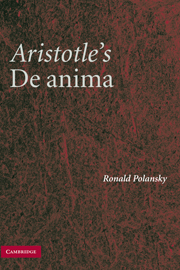Book contents
- Frontmatter
- Contents
- Preface
- List of Abbreviations
- Introduction
- COMMENTARY ON DE ANIMA: : Book 1
- COMMENTARY ON DE ANIMA: Book 2
- 1 Definition of Soul
- 2 What Is Life?
- 3 How Powers of Soul Are Distributed and United in the Soul
- 4 The Nutritive Faculty: Its Object and Subfaculties
- 5 Clarification of Being Affected, Living as Saving, and the First Definition of Sense
- 6 The Three Sorts of Sensible Objects
- 7 Vision, Medium, and Object
- 8 Hearing, Sound, and Voice
- 9 Smell and Odor
- 10 Taste Is a Contact Sense; the Tasteable
- 11 Touch, the Tangibles, and Sense as a Mean
- 12 Definition of Sense and Whether Sensibles Affect Nonperceiving Bodies
- COMMENTARY ON DE ANIMA: Book 3
- Bibliography
- Index
6 - The Three Sorts of Sensible Objects
Published online by Cambridge University Press: 18 December 2009
- Frontmatter
- Contents
- Preface
- List of Abbreviations
- Introduction
- COMMENTARY ON DE ANIMA: : Book 1
- COMMENTARY ON DE ANIMA: Book 2
- 1 Definition of Soul
- 2 What Is Life?
- 3 How Powers of Soul Are Distributed and United in the Soul
- 4 The Nutritive Faculty: Its Object and Subfaculties
- 5 Clarification of Being Affected, Living as Saving, and the First Definition of Sense
- 6 The Three Sorts of Sensible Objects
- 7 Vision, Medium, and Object
- 8 Hearing, Sound, and Voice
- 9 Smell and Odor
- 10 Taste Is a Contact Sense; the Tasteable
- 11 Touch, the Tangibles, and Sense as a Mean
- 12 Definition of Sense and Whether Sensibles Affect Nonperceiving Bodies
- COMMENTARY ON DE ANIMA: Book 3
- Bibliography
- Index
Summary
Having determined in the previous chapter that there are external particular sensible objects, and having arrived at a general account of the perceptive power as the capacity to become likened to these sensible objects as they are sensible in actuality, Aristotle turns to what in general these sensible objects are. He indicates that he first (πρῶτον) considers the objects of each sense (καθ᾽ ἑκάστην αἴσθησιν) since if he is going on to treat each of the senses it is appropriate to understand faculties and operations in terms of their objects (418a7–8; cf. 415a16–22). “Of each sense” here really means each kind of sense, whatever kinds there are, since the Greek καθ᾽ ἕκαστον can refer to kinds as well as to particulars (see 414b32–33 for καθ᾽ ἕκαστον referring to kinds and 417b22 for τῶν καθ᾽ ἕκαστον applying to particulars). Talk of kinds of senses is pertinent insofar as different types of animals share kinds of senses and inasmuch as some sensible objects are perceived in virtue of themselves (καθ᾽ αὑτά), that is, in virtue of the kind of sensible object and the kind of sense. Aristotle must delineate the possible sorts of objects of the various kinds of sense perception and indicate which play the central role in the accounts of the senses. Only afterward will he be ready to treat more particularly each kind of sense, its special object and operation.
The chapter's concision is remarkable in view of its importance.
- Type
- Chapter
- Information
- Aristotle's De AnimaA Critical Commentary, pp. 250 - 262Publisher: Cambridge University PressPrint publication year: 2007



